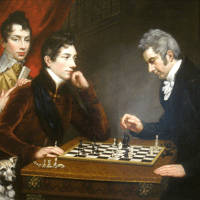
When Both Sides Try to Lose
Black (newble) shared this game and asked, “Please tell me what I did wrong.”
Well, Mr. newble, it won’t be pretty, but if you insist, I’ll obey! Keep in mind that it’s not just what you did wrong, it’s what you both did wrong.
9.Nxf7?!
Instead of forcing the draw with this tempting Knight sacrifice, White should have played 9.Qh5:
9…Kxf7 10.Qf3+??
This badly thought out Queen check gives Black a clear advantage because White is literally forcing black’s King to run to safety on the queenside. Instead, 10.Qh5+ doesn’t allow a queenside dash:
10...Ke8??
This walks into a deadly check on g6. Instead, 10…Ke7 avoids that check and ends the attack since 11.Bg6 can be answered by 11…Be8.
11.Qh5+??
Instead of forcing black's King to run to safety, the insanely obvious 11.Bg6+ (which is begging to be played) wins immediately:
11...Kd8
12.Qf7 Be7??
Instead of hysterically giving away your pieces, 12...Kc7 (or 12…Nge7) hangs on to everything and would have placed White in a hopeless situation. When someone threatens to eat one of your pieces (with check no less), defending that piece is usually a good idea.
13.Qxg7 Nxd4 14.Qxh8 Kc7 15.Bxh6?
Instead of chopping a useless pawn, allowing ...Qxb2 in some lines, and sticking the Bishop on the wing, both 15.c3 (kicking away the active enemy Knight) and 15.Nc3 (developing) would have led to an easy win.
15...Qa7??
Pouring hope down the drain. When you are behind in material and getting crushed, you need to play sharply, make sure your pieces are as actively placed as possible, and hope for a bit of luck (active pieces often create their own luck). Retreating and defending your Rook just won’t get the job done in such a situation.
Instead of black's passive resignation to his fate, he should have demanded active play by 15...c4:
16.c3 Nf5 17.Bxf5 exf5 18.e6 Bxe6 19.Qe5+ Kd7 20.Bf4, 1-0.
This game went back and forth on every move! Why? Because each side faced a situation where a clear problem had to be solved, and in almost every instance, they failed to find the solution. Thus we saw random checks that actually helped the opponent, and the giving away of pieces that could have easily been avoided. This kind of game, where both sides seem to be trying to lose, is typical of players who are just starting out. So please don’t feel ashamed, since we all go through this stage. Fortunately, with a bit of experience and work, both sides will be able to avoid checks that don’t do anything, and avoid giving away pieces if they can be easily defended. Once you get through that initial "giving everything away" phase, the sky is the limit.
LESSONS FROM THIS EXAMPLE
* If you’re attacking the enemy King, don’t force that King to run to safety by giving useless checks. Instead of allowing it to dash, do your best to keep it in the danger zone.
* When your King is coming under heavy fire and is vulnerable to all sorts of checks, you need to carefully weigh the result of each and every check so you can avoid a life-ending blow.
* When you are down material and getting crushed, you need to play sharply, make sure your pieces are as actively placed as possible, and hope for a bit of luck (active pieces often create their own luck). Passive play in such a situation will always lead to a bloody demise.
* When your pieces are threatened, protect them!
HOW TO PRESENT A GAME FOR CONSIDERATION
If you want me to look over your game, send it to askjeremy@chess.com
I need your name (real or chess.com handle), your OPPONENT’S name (real or chess.com handle), both players’ ratings, where the game was played, and date. If you don’t give me this information, I won’t use your game! BTW: I’ve noticed that many people are reluctant to give me their opponent’s name. This is very strange! Showing the names of both players is the way chess games are presented in databases, books, magazines… everywhere! Permission from the opponent isn’t necessary. If permission was necessary, everyone who ever lost a game wouldn’t allow their name to be on it!






